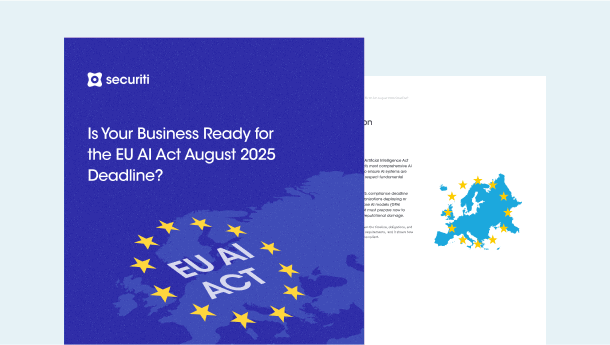The United Arab Emirates (UAE) recently passed the Federal Decree-Law No. 45 of 2021 on the Protection of Personal Data (PDPL) in November 2021. The PDPL acts as the primary federal legislation dealing with data privacy and data protection within the UAE. Like most other data protection laws, it mandates companies to take robust measures to protect all the data they collect on data subjects. Naturally, this means companies covered under the new law will have to transform and, in many cases, completely rework the way they process their users' data.
Hence, it's easy to see why compliance must rank high among the immediate goals for companies collecting data on users in the UAE. This UAE compliance checklist makes things easier by elaborating the basic steps a company needs to take to comply with the new PDPL.
Does UAE's Personal Data Protection Law Affect You?
As per the new law's Article 2(1), any organization registered in the UAE and collecting data on data subjects inside or outside the UAE comes under the scope of the PDPL, this includes companies that might be collecting data on behalf of another company.
The law also applies to all businesses that may not be registered in the UAE but process data of UAE residents. Some notable exemptions to the new PDPL include government data, public entities' data, and health and credit data subject to their own dedicated legislation. Companies established and registered within the free zones, such as the Dubai International Financial Centre (DIFC) and the Abu Dhabi Global Market (ADGM), are also exempt.
UAE Compliance Checklist
If a company falls within the scope of the new PDPL based on the criteria mentioned above, it must develop a compliance checklist to initiate its compliance activities. Here are some of the most critical areas to get started on:
Conduct Data Mapping Exercise
A data mapping exercise to start things off will allow the data controller to see precisely where and how they stand when it comes to collecting and storing data subjects' data. Among other things, this relatively easy-to-conduct exercise can illustrate for a data controller the following things:
- Data collected, processed, stored, and transferred by the data controller
- Why was the data collected
- Where was the data collected from
- Where is the data stored and transferred
- Whom does the data controller share or sell data subjects' data to
Identify the Lawful Basis of Processing of Personal Data
Under the PDPL, organizations can process personal data only on a lawful basis. The PDPL provides several lawful bases for the processing of personal information. Please find these lawful bases listed below and ensure that your organization relies on one of these bases for the processing of personal information.
- To protect the data subject’s interests
- The data subject’s personal data is available publicly
- Processing of personal data is essential for medical reasons
- Processing of personal data is essential for legal or security reasons
- For scientific, historical, archival, and statistical studies purposes
- Processing of personal data is essential for the data handler’s compliance with the law
- Any other circumstances that might be highlighted by the Executive Regulation in the future
Develop Appropriate Consent Mechanism & Policies
If relying on consent as a lawful basis of processing, then your organization must fulfill all the consent requirements. The precise use of language is vital, and gaining proper consent has become even more critical under the new PDPL guidelines as a result. Not only does the language when requesting consent need to be clear, but it is also crucial that it be worded according to the purpose your organization aims to use the data collected. Your organization must also provide a convenient mechanism for individuals to withdraw their consent.
Similarly, your organization must also ensure that their privacy policy and the data subjects' rights are communicated clearly in unambiguous terms.
Fulfill Cross Border Data Transfer Obligations
The PDPL does allow for cross-border data transfers. However, this can only be done if it is approved by the UAE Data Office. It is up to the data handler in question to ensure that the Data Office is satisfied that the data being transferred will receive an “adequate level of protection” wherever it is being transferred. The cross-border transfer of personal data to inadequate countries can also be done in the following circumstances:
- Under a contract that applies the requirements of the PDPL (standard contract clauses);
- After obtaining the data subject’s express consent for such transfer;
- If the transfer is necessary for the execution of a contract between the controller and the data subject or as part of a contract between the controller and a third party that achieves the interests of a data subject;
- If the transfer is necessary for international judicial cooperation;
- If the transfer is necessary to protect the public interest.
A data handler must have detailed files and contingency plans on all jurisdictions in the world where the data collected might need to be transferred. Having these will ensure a smooth appraisal process by the Data Office and negate the chances of such a request being denied.
Provide Privacy Notices To Individuals For The Processing Of Their Personal Data
A robust privacy policy can go a long way in alleviating the issues faced by the data handler or even eliminating them before they even become problems.
While it might seem like a mundane task, it ensures that all data subjects whose data is being collected are acutely aware of the processing activities they will be subject to. Moreover, it also allows the data handler to declare in detail whether they plan to sell or share the collected data with any third-parties. Simply educating the data subjects on these matters can contribute immensely towards the company’s overall data compliance.
This is arguably the most cumbersome part of the new legislation. It requires data controllers to conduct a data protection impact assessment (DPIA) each time a new technology or technique is introduced that might hinder the privacy of the data collected on the data subjects.
The law itself is explicit in the language stating that a DPIA must be conducted "each time" a new technique, tool, or technology is introduced. Most data controllers would be well-advised to carry out regular DPIAs regardless of whether they're adding new technology or not. This would ensure a data controller knows the state of their data protection mechanisms on a regular basis while identifying any lapses or room for improvement.
Appoint a Data Protection Officer
The law calls on all data controllers that fall under the scope of the PDPL to appoint a dedicated Data Protection Officer (DPO) if the data controller is:
- Conducting data processing activities that pose a high risk to the privacy of the data subjects' data owing to the adoption of new technologies
- Conducting data processing activities that involve the use of sensitive personal data for profiling or automated decision-making
- Conducting data processing activities that require the processing of a significant amount of sensitive personal data
The DPO appointed can be an existing staff member or an expert on the PDPL and does not need to be permanently based in the UAE.
Maintain a Record of Processing Activities
The PDPL is primarily inspired by the GDPR in this area as it requires all data controllers to maintain an extensive and regular record of processing activities (ROPA). Moreover, it goes beyond the GDPR in this particular area. It also requires all data controllers to include "the data of the persons authorized to access the Personal Data" in its ROPA.
The purpose behind this is to oversee just how exposed the collected data is and ensure that only individuals with the proper credentials and reasons are ever allowed to have access to this information.
Maintain a Comprehensive DSR Framework
The PDPL gives data subjects several rights to their data. This includes rights of access, objection, deletion, portability, rectification, and a right to object to automated processing decisions being made. While there are some notable exceptions to when data subjects can exercise these rights, for the most part, your organization needs to ensure that they have an easy-to-use process for data subjects to use when they wish to make these requests.
Develop a Data Breach Response Process
This is venturing into the "worst-case scenario" settings, but the PDPL requires all data controllers to have an extensive data breach notification mechanism in place. With that in mind, the relevant employees within the data controller must know their exact roles in initiating a counter-response to the data breach. This can only be possible if the data controller has a comprehensive, detailed, and effective data breach response plan in place.
Similarly, all parties that need to be notified of the breach, such as the data subjects affected, the relevant authorities, and the press, must be informed as soon as possible.
Final Word
While the law is expected to come into effect from 02 January 2022, there are several areas within the law where additional legislation will be required. One such key area is the penalties for non-compliance. Unlike other data protection laws, there are no standardized penalties yet. The courts and the UAE Data Office will dish out penalties for non-compliance on a case-by-case basis. Hence, companies processing UAE residents' data must speed up their adoption of the above-mentioned UAE compliance checklist.
Securiti prides itself on being a market leader in offering data-driven solutions related to data privacy and data protection. Using robotic automation, artificial intelligence, and machine learning, its tools can help your company attain compliance with all of PDPL's provisions at the click of a button. Request a demo today to see how Securiti can help your organisation in its compliance ambitions.








































